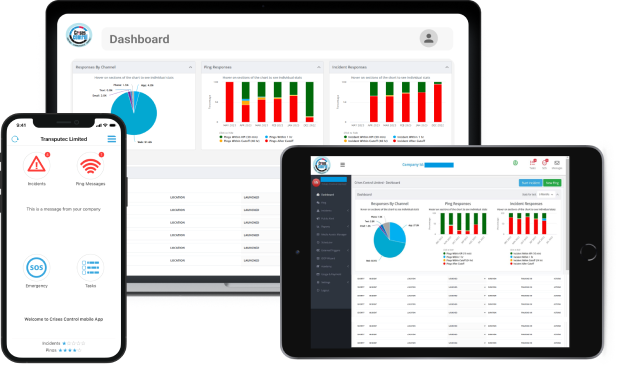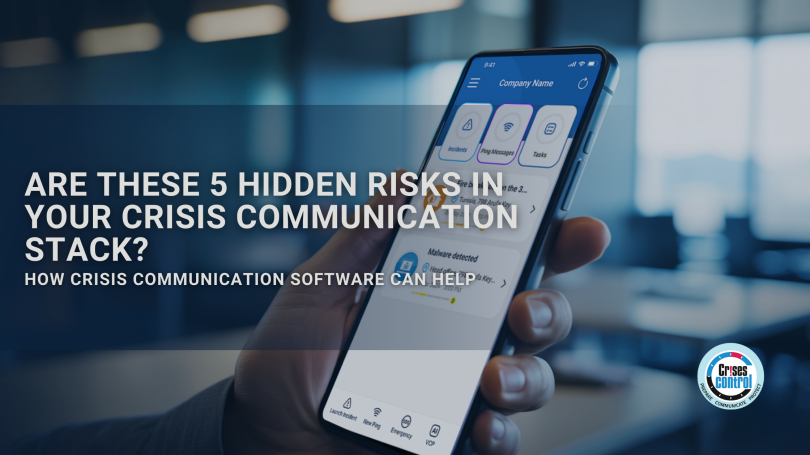Written by Anneri Fourie | Crises Control Executive
When you think your organisation is ready for a crisis, it’s usually because you’ve ticked the boxes: plans in place, systems installed, training sessions completed. But the real test doesn’t come during a scheduled drill. It comes when something goes wrong.
You press send on an emergency alert, and then… silence. Or worse, chaos.
This is where cracks in your crisis communication stack start to show. And the trouble is, these gaps are often invisible until you’re right in the middle of an incident. They don’t live in your strategy documents, they live in your processes, systems, and assumptions.
In this blog, we’ll uncover five often-overlooked weaknesses that can leave your organisation exposed. More importantly, we’ll look at how the right Crisis Communication Software can close those gaps before they cost you time, money, or reputation.
1. Just Because You Sent It Doesn’t Mean They Got It
What Usually Goes Wrong
Many businesses rely on systems that can tell them a message was “sent” or even “delivered”. But that’s not the same as the message being seen, understood, or acted upon. During a crisis, assuming that people are reading their emails or checking their phones on time can be a costly mistake.
How It Played Out in Practice
A logistics firm handling hazardous materials had a spill onsite. They triggered their alert system, confident that the right people were informed. In reality, some team members were in poor coverage zones; others missed the email entirely. The result? A slow, fragmented response that allowed the situation to escalate.
The Solution
Crises Control removes the guesswork. Its platform gives you real-time visibility into who has received, opened, and acknowledged a message. You’ll know exactly who’s seen the alert, and who hasn’t, so you can follow up, escalate, or re-route as needed.
2. Relying on a Single Communication Channel Is a Gamble
What Usually Goes Wrong
Many organisations depend too heavily on one method, usually email. But emails get buried. SMS can fail in poor signal areas. Apps need mobile data. In short, if you’re counting on a single route, you’re leaving too much to chance.
How It Played Out in Practice
When a ransomware attack hit a mid-sized financial services firm, their internal email system went down. They had no other way to reach employees quickly. Critical instructions, like disconnecting certain systems, never reached the right people, and the attack spread further than it should have.
The Solution
Crises Control delivers messages across multiple channels simultaneously or in a cascading sequence; SMS, email, voice calls, push notifications, and even desktop alerts. If one method fails, others kick in. You get peace of mind knowing your alerts will break through, no matter the disruption.
3. Outdated Contact Lists Can Derail Your Response
What Usually Goes Wrong
It’s easy to assume your contact lists are up to date. But people change roles, leave the company, or join new teams, and unless your system is actively managed, it’s likely you’re relying on old data when it matters most.
How It Played Out in Practice
A manufacturing company issued an alert during a factory equipment failure. The alert system ran smoothly, except it was still using a six-month-old list. Key response team members had moved on. Valuable time was lost trying to reach people who were no longer available.
The Solution
Crises Control connects with your existing HR and IT systems to keep contact information up to date. You can also set regular reminders for staff to review and confirm their own details, so your system stays ready and reliable.
4. One-Way Messaging Isn’t Enough in a Real Crisis
What Usually Goes Wrong
Too many organisations use communication systems designed to broadcast, not listen. Sending out instructions is only half the job. If you can’t gather feedback, check progress, or receive updates from your team, you’re operating in the dark.
How It Played Out in Practice
A national retail chain issued a closure notice to stores during severe flooding. Store managers had questions and needed to share road closures and local updates, but the alert system didn’t allow replies. Head office assumed everything was fine. It wasn’t.
The Solution
Crises Control enables two-way communication. Staff can reply to alerts, confirm safety, report conditions, or escalate issues directly from the message. It gives leadership an immediate view of what’s happening on the ground, helping you adjust your response in real time.
5. Manual Processes Slow Everything Down
What Usually Goes Wrong
When your crisis response relies on someone digging through documents, selecting templates, and manually launching each step, you’re at the mercy of stress, delays, and human error. That might work in theory, but it rarely holds up under pressure.
How It Played Out in Practice
An IT team dealing with a data breach spent over 30 minutes locating the correct message templates and stakeholder lists. By the time they sent the first alert, social media had already started spreading false information, increasing customer anxiety and damaging their credibility.
The Solution
With Crises Control, you can build pre-configured workflows that automatically trigger the right actions for different types of incidents. Whether it’s a cyberattack, physical emergency, or supply chain issue, the platform activates the correct steps immediately, sending the right messages, to the right people, in the right order.
Why These Risks Are So Often Missed
These weaknesses don’t show up on checklists. They’re hidden beneath the surface, masked by day-to-day routines and false assumptions. Your system might look like it’s working fine during drills. But drills don’t mimic chaos.
What you need is a system that performs when there’s noise, confusion, and pressure. That means fewer manual tasks, smarter automation, reliable multi-channel delivery, and real-time oversight.
What to Look for in Effective Crisis Communication Software
If you’re reviewing your crisis response tools, here’s what to prioritise in Crisis Communication Software:
Multi-Channel Messaging
You need a platform that doesn’t rely on a single point of failure. SMS, email, voice calls, desktop notifications, these should all be available and automatic.
Real-Time Feedback and Acknowledgement
Look for systems that show you who’s received, opened, and responded to alerts, so you can adjust your response as things unfold.
Seamless Integration
Your contact data should update regularly. If your communication system doesn’t talk to your HR and IT systems, it will become stale and unreliable fast.
Two-Way Communication
A truly effective platform lets you hear back from the field, not just shout instructions into the void. You need to gather intelligence while taking action.
Ready-Made Workflows
Every second counts in a crisis. Look for solutions that allow you to trigger complete workflows; notifications, tasks, and escalations, with one click.
How Crises Control Helps
Crises Control brings all these features together in a single, cloud-based platform built for real-world resilience. Used by companies in finance, logistics, healthcare, manufacturing, education, and government, it’s trusted to manage everything from cyberattacks and outages to weather emergencies and operational failures.
Whether you’re dealing with a major incident or preparing for one, Crises Control combines a robust Mass Notification System, intelligent Incident Management Software, and intuitive Crisis Communication Software, all designed to help you act quickly, stay informed, and keep control.
You can manage everything from your phone, monitor response progress in real time, and automate the steps your team needs to follow under pressure.
Final Thoughts: Be Ready Before It Matters
The scariest thing about the risks in your crisis communication setup is that you often don’t know they exist, until it’s too late. These hidden weaknesses can seriously delay your response and lead to poor decisions during your most critical moments.
But they’re fixable.
Modern, intelligent Crisis Communication Software like Crises Control helps you uncover and eliminate these vulnerabilities before they cause damage. You’ll be better prepared, better informed, and able to respond with confidence, no matter what hits you next.
Book a Free Demo
Not sure if your current system could hold up during a real incident?
Let us show you what Crises Control can do.
Book a free demo today and discover how to modernise your crisis communication approach, remove hidden risks, and protect your people and operations.
Request a FREE Demo

